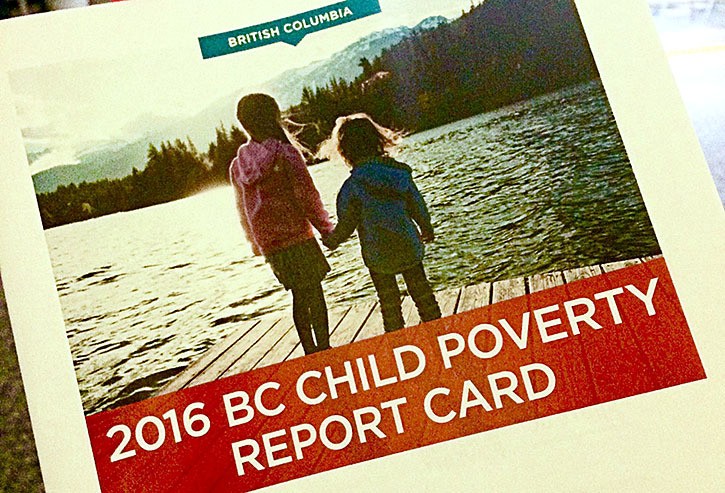The just released 2016 B.C. Child Poverty Report Card blames a lack of affordable childcare, a too low minimum wage and inefficient government benefits for keeping one in five children across B.C in poverty.
That’s 1.5 per cent higher than Canada’s child poverty rate of 18.5 per cent and four per cent higher than the overall poverty rate in B.C. Child poverty rates differ across the province with the highest rates in Duncan at 31 per cent, and Port Alberni and Prince Rupert, both at 30 per cent. The lowest rates are Fort St. John at 12 per cent, Squamish at 15 per cent and Victoria at 16 per cent.
Just over half of poor children in B.C. live in Metro Vancouver and the area has a 19.3 per cent child poverty rate overall. The Guildford, Newton and Whalley areas of Surrey have the highest number of children living in poverty, while northeast Vancouver has the highest percentage out of its under 18 population.
The report, produced annually by child and youth advocacy group First Call B.C., uses Statistics Canada’s low-income measure (LIM) from 2014 as Canada does not have an official poverty line. Newer figures from Statistics Canada are not yet available.
The child poverty report card advocates measures to reduce the rate, including a $15 an hour minimum wage, a living wage for all employees (calculated at $20.40 for Metro Vancouver) and a redesign of the B.C. Early Childhood Tax Benefit into a B.C. Child Benefit that covers children up until 18 years of age at double the rate.
Metro #Vancouver has resources and responsibility to be a leader in fighting child #poverty, says @FirstCallBC exec. director Scott Graham pic.twitter.com/Pt3Fc39GKv
— Kat (@katslepian) November 24, 2016
The child poverty rate in B.C. has dropped 0.6 per cent since last year’s report, which used 2013 figures. However, according to First Call B.C., the rate rose from 15.5 per cent in 1989 to 25.3 per cent in 2000, before dropping down to 2014’s 19.8 per cent.
First Call BC attributes what it calls a “meagre” four per cent decrease in child poverty rates between 2000-2014 partially to B.C.’s lack of poverty reduction plans. B.C. is the only province in Canada not to have one. Other provinces such as Quebec and Nova Scotia have brought down their rates by 16 per cent in that time frame.
The report notes that children in single-parent households have a much higher chance of living in poverty than do children in couple families – 50 per cent compared to 12 per cent. Eight out of 10 of those single-parent families are female-led, leading to a recommendation from First Call B.C. to implement the $10-a-day childcare plan and increase the time and pay for maternity and parental care.
But the province said that it is taking steps to make childcare affordable.
“We’ve supported the creation of more than 4,300 new licensed child-care spaces since 2014, invested in 47 new BC Early Years Centres throughout the province, and introduced the new B.C. Early Childhood Tax Benefit to help families with the cost of raising young children,” said Children and Family Development Minister Stephanie Cadieux.
She also said that the province’s single parent employment initiative, which provides people on income and disability assistance with 12 months of funded training for in-demand jobs, is aimed at helping single parents struggling to make ends meet. Almost 4,000 people have signed up for the program and close to 700 have found employment, according to the province
Kris Archie, manager of Fostering Change at the Vancouver Foundation, said a recent study by the foundation in partnership with SFU researchers, determined the current policy of dealing with young people aging out of foster care triggers up to $268 million in additional costs.
“That’s the cost of doing nothing,” Archie said. “These costs include the cost of homelessness, hospitalization, mental health issues and concerns and reduced incomes over their lifespans.
“However, if we choose investment in young people we know that $57 million is what that investment would look like to drastically change the reality of poverty and increase the likelihood of success when young people leave foster care.”
B.C. Teachers Federation president Glen Hansman said a province-wide BCTF survey three years ago of poverty-related challenges that teachers were witnessing in their students was ignored by the B.C. government at the time.
“There was very, very little interest,” Hansman said.
2016 BC Child Poverty Report Card by Ashley Wadhwani on Scribd
Like us on Facebook and follow us on Twitter.
